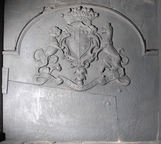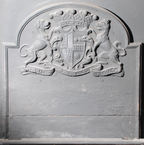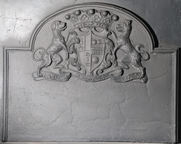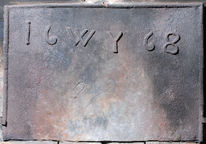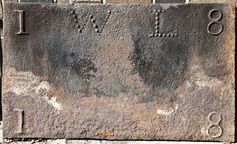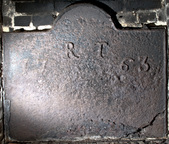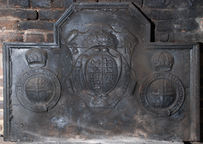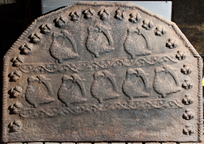-
248
Description: Arched rectangular shape; astragal and fillet edging; shield, motto, earl’s coronet and supporters (a talbot erm. and a wolf or, ducally crowned gu.) of Stanhope impaling Pitt: quarterly (1st & 4th) erm. (2nd & 3rd) gu. (Stanhope); sa., a fess chequy az. and ar. between three bezants (Pitt); motto: A DEO ET REGE.
Notes: James Stanhope was created 1st Earl in 1718; he had married Lucy Pitt in 1714. The Stanhope seat was Chevening, near Sevenoaks.
Inscription: A DEO ET REGE
Arms: Stanhope impaling Pitt; James, Ist Earl Stanhope
- Decoration tags:
- rectangular with round arch (shape)
- astragal & fillet (edging)
- carved pattern panels
- armorial
- text
Manufactured: in the early-18th century in England.
Current location: Chevening Park, Chevening, Kent, England.
- Attached to series:
- Personal armorial firebacks
- Stanhope series
-
249
Description: Arched rectangular shape; astragal and fillet edging; shield, motto, earl’s coronet and supporters (a talbot erm. and a wolf or, ducally crowned gu.) of Stanhope impaling Pitt: quarterly (1st & 4th) erm. (2nd & 3rd) gu. (Stanhope); sa., a fess chequy az. and ar. between three bezants (Pitt); motto: A DEO ET REGE.
Notes: James Stanhope was created 1st Earl in 1718; he had married Lucy Pitt in 1714. The Stanhope seat was Chevening, near Sevenoaks.
Inscription: A DEO ET REGE
Arms: Stanhope impaling Pitt; James, 1st Earl Stanhope
- Decoration tags:
- rectangular with round arch (shape)
- astragal & fillet (edging)
- carved pattern panels
- armorial
Manufactured: in the early-18th century in England.
Current location: Chevening Park, Chevening, Kent, England.
- Attached to series:
- Personal armorial firebacks
- Stanhope series
-
250
Description: Arched rectangular shape; astragal and fillet edging; shield, motto, earl’s coronet and supporters (a talbot erm. and a wolf or, ducally crowned gu.) of Stanhope impaling Pitt: quarterly (1st & 4th) erm. (2nd & 3rd) gu. (Stanhope); sa., a fess chequy az. and ar. between three bezants (Pitt); motto: A DEO ET REGE.
Notes: James Stanhope was created 1st Earl in 1718; he had married Lucy Pitt in 1714. The Stanhope seat was Chevening, near Sevenoaks.
Inscription: A DEO ET REGE
Arms: Stanhope impaling Pitt; James, 1st Earl Stanhope
- Decoration tags:
- rectangular with round arch (shape)
- astragal & fillet (edging)
- carved pattern panels
- armorial
- text
Manufactured: in the early-18th century in England.
Current location: Chevening Park, Chevening, Kent, England.
- Attached to series:
- Personal armorial firebacks
- Stanhope series
-
35
 ? x ? mm
? x ? mmDescription: 'Dutch' style; arched rectangular shaped with bead edging; figures of a man and woman walking, in dress of the mid-17th century, a page holding the woman's train. followed by a man holding a parasol, and by a horse; they pass between the bases of two columns; above is foliage and clouds. On top are two serpents and three pomegranates arranged symmetrically.
Notes: The pictorial scene is based on an engraving c.1642 of Friedrich Wilhelm, Elector of Brandenburg, and his wife, Luise Henriette of Oranje-Nassau, by Mathias Czwiczek; one of series of firebacks depicting allegories of the four continents.
Copies of this fireback are known.
Manufactured: in the mid-17th century .
Current location: in private hands, Chichester, West Sussex, England.
- Attached to series:
- 'Dutch' Continents firebacks
- 'Dutch' Borderless series
-
255
Description: Rectangular; twisted rope edging (top and sides); along upper half of plate, date split with initials in between.
Notes: The initials are likely of William Yalden (d.1674), an ironmaster who was active in north-west Sussex and south-west Surrey where this and other similar firebacks have been noted.
Inscription: 16 WY 68
- Decoration tags:
- rectangular (shape)
- rope (edging)
- individual letters
- individual numbers
- text
Manufactured: in 1668 in the Weald area of England.
Current location: Ramster, Chiddingfold, Surrey, England.
- Attached to series:
- William Yalden series
- Date & initials firebacks
-
1299
Description: Rectangular shape without edging; date in an elegant Roman style split between top and bottom corners; top centre, beaded initials WL.
Notes: The dotted initials are unusual, in all probabiltiy the dots being individually pressed into the moulding sand.
Inscription: I W L 8 / 1 8
- Decoration tags:
- rectangular (shape)
- none (edging)
- simple stamps
- carved stamps
- individual letters
- individual numbers
- text
Manufactured: in 1818 in England.
Current location: in private hands, Chiddingly, East Sussex, England.
- Attached to series:
- Date & initials firebacks
-
1298
Description: Arched rectangular shape; astragal edging (top and sides); top centre, initials RT, widely split date below.
Notes: Simple fireback with a pair of initials and date. The '3' of the date is from a different set of numerals from the others.
Inscription: RT / 17 63
- Decoration tags:
- rectangular with round arch (shape)
- astragal (edging)
- carved stamps
- individual letters
- individual numbers
- text
Manufactured: in 1763 possibly in the Weald area of England.
Current location: Farley Farmhouse, Muddles Green, Chiddingly, East Sussex, England.
- Attached to series:
- Date & initials firebacks
-
260
Description: Quasi-arched rectangular shape, with 5-facetted arch; cyma recta moulded edge; oval Tudor royal shield on a cartouche surrounded by a garter, a crown above separating the initials, ER, all on a larger cartouche; on either side a circular Tudor royal shield within a garter, with a crown above each.
Notes: The word ‘PENSE’ in the garter mottoes is differently spelled on the central stamp — ‘PENCE’ - and the outer stamps — ‘PANSE’ (where the ‘N’ is reversed). The outer stamp has been noted on three firebacks dated 1589. Three horizontal planklines on central cartouche.
Copies of this fireback are known.
Inscription: ER [and Garter mottoes]
Arms: Tudor royal
- Decoration tags:
- rectangular with five-facetted arch (shape)
- cyma recta (edging)
- carved stamps
- carved pattern panels
- planklines
- armorial
- royal
- text
Manufactured: in the late-16th century in the Weald area of England.
Current location: in private hands, Chiddingstone, Kent, England.
- Attached to series:
- 1589 series
- Tudor royal armorial firebacks
-
1201
Description: Rectangular with five-facetted arched shape; twisted rope edging (top and sides); small flower-bud stamp repeated 23 times inside the edging; across the middle of the fireback, two approximately parallel lines of lengths of vine strip moulding inclined up to the right; between them, five bird stamps, probably swans (a Lancastrian badge), the front of their left wings 'displayed and inverted', and three more swans above the top line of vine strip moulding.
Notes: The stamps are all seen on other firebacks in the same series. The five-facetted arch is seemingly unique. A very similar fireback with minor differences was lot 2630 at Toovey's auction, Washington, West Sussex, 19 Jun 2015.
Copies of this fireback are known.
- Decoration tags:
- multi-facet arched (shape)
- rope (edging)
- carved stamps
- animals
- objects
Manufactured: in the late-16th century possibly at Pounsley Furnace, Framfield in the Weald area of England.
Current location: in private hands, Chiddingstone, Kent, England.
- Attached to series:
- Pounsley series
- Swan series
- Vine strip series
-
257
Description: Arched rectangular central panel with ‘nutshell’ edging on a broad fillet; crowned figure, holding a sceptre in his right hand, sitting in a chariot drawn to the left by two horses with ostrich feather head-dresses; the whole upon a causeway with pilasters and masonry, and waves beneath; a heron flying to the left; above, swagged drapery with two tassels hanging from the centre; arched rectangular shaped border with fillet edging, symmetrical, flower bunches, descending from a ribbon loop; monogram centre bottom, between plant tendrils; on top, symmetrical scrolled plant tendrils.
Notes: The design is derived from a personification of Europe, one of a set of playing cards entitled 'Jeu de la Géographie', designed by Stefano della Bella (1677); a similarity with Queen Anne may not be coincidental; the flying heron has been copied from a print by Wenceslaus Hollar c.1658.
Copies of this fireback are known.
Inscription: SHR
Manufactured: in the late-17th to early-18th century in England.
Current location: Chiddingstone Castle, Chiddingstone, Kent, England.
- Attached to series:
- SHR series
- British 'Dutch' style firebacks
